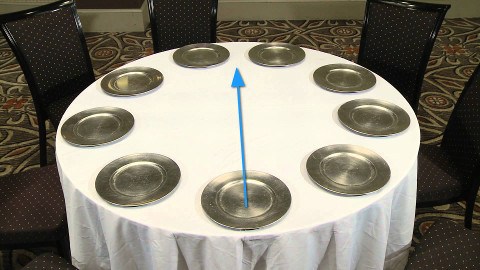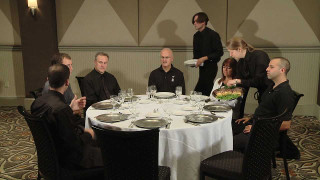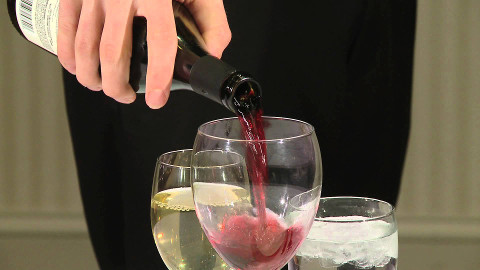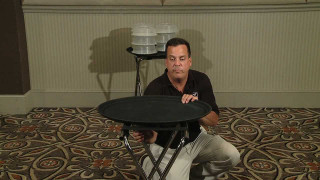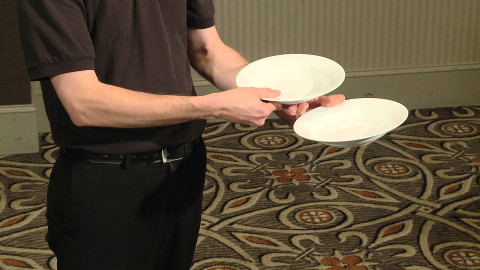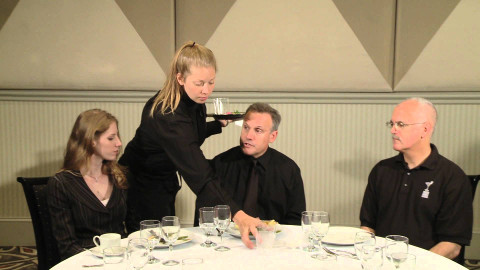
- You are here:
- Homepage
- › Online Courses
- › Service course
Service Training for Catering, Gastronomy & Waiters
Catering training for service hostesses, restaurants & waiters incl. videos, as well as an online quiz with 41 questions
How do I set a table? How to serve wine or other beverages? And how do I correctly carry three plates at once? For these and other questions in the service, gastronomy and catering area, we made this free course available. Take a good look at the short introductory videos and read the educational text on this page and you should be set to correctly answer the questions in the service test.
If you are already registered as a host / hostess at InStaff, please use the same e-mail-address for the test. If you successfully pass the test, we will remark this on your profile. This way, potential clients will know about your theoretical service knowledge, improving your chances of getting booked.
At least 75% required to pass
Test can be taken 3 times
You receive a badge for your InStaff profile
Introductory Videos
Please look at the following video regarding the subject of serving food and Sweep Service for introductory purposes. The six additional videos are optional.
Serving food
Fundamentals
Legal employment
The work of a waiter or service staff is generally a dependent employment, at which you as an employee have to be billed through income tax card (Lohnsteuerkarte). You cannot get paid through trade license (“on account”), as you offer your sole workforce and do not bear any entrepreneurial risk. Should a company bill you through trade license or give you cash money, this is called pseudo-self-employment or illegal employment. You will have to report this to the financial control of illegal employment.
Salary and tips
In the whole of Germany, the minimum wage is 8.50 €/h. On fairs and congresses you will probably earn significantly better, as the typical hostess salary is in the range of 10-14 €/h. This income is regularly taxed, yet you will get back the paid taxes at the end of the year (that’s if you earn 10,000 € or less). Additionally, there may be social security contributions, however at InStaff, you will not have to pay these as you are a short-term employee.
On fairs, congresses and similar events you will regularly not receive tips. . Deployments for restaurants or ceremonial occasions may very likely include tips for you. Should a guest free-spiritedly tip you, you may keep it tax-free. Your employer is not allowed to take it from you or take it into account for your salary. Still, it is usual in many industries that tips are collected and evenly split between all employees, so e.g. the chefs can profit, too.
Instructions on Infection Protection Law (IfSG)
If you come into contact with food at work, you will need a so-called health certificate (“Gesundheitszeugnis”) by §43 Abs. 1 IfSG. This initial instruction is valid for life, if the instructed person has started her employment within 3 months after the initial instruction. The employer is then obliged to carry out follow-ups at the start of the employment, as well as in a two year interval.
Your city’s health department offers initial instructions. Depending on the respective health department, this will cost between 13 and 36 €. You will have to personally cover this.
Appearance
It is important that you evoke a positive first impression. For the most part, this depends on your outer appearance. There are a few fundamental guidelines which need to be adhered to.
Clothes
Regarding your clothing, you should generally focus on a cultivated and neat look. This can be achieved by orderly, clean and freshly smelling garments. Your clothing should not be too flashy, in most cases a plain white blouse and black cloth pants are adequate. At more sophisticated occasions, it might be the case that you receive clothes to ensure an uniform appearance of the staff. Your shoes should be elegant, modest and comfortable. High-heels are not only inadequate for service, they also produce pain. As service staff, you are in movement for many hours a day. Work shoes should therefore be simultaneously comfortable and classy. Flat and closed shoes are best. Additionally, jewelry on arms and hands is off-limits.Accessories
Renounce from wearing headgear. Instead, place value on a neat haircut. Should you want to wear make-up, that’s okay, but use only decent tones. If you wear perfume, keep it on a reasonable level. Cared hands without nail-polish display excellent service knowledge. Chewing gum is understandably inadequate.Before starting service
Preparation
To adequately prepare the location, the room(s) should be thoroughly aired before the first guests arrive and brought to a pleasant temperature. Clean floors, windowsills, tables and cutlery are obligatory. Candles should be exchanged and flowers tested for freshness. If smoking is still permitted, every ashtray should be clean and empty. The sanitary areas should also be tested for complete accessories. Most importantly toilet paper, but also soap and towels should be available in suiting amounts.Recpetion
Welcoming the guests is very important, as the first verdict on service is made here. It is always positive to make towards to guests a little as soon as they enter the room. It is regarded as polite to be helpful at the wardrobe and choosing a table. Especially important is to welcome the children just as politely as the adults and taking their wishes seriously. When in contact with guests, a friendly and natural smile, as well as an generally polite demeanor is indispensable.Setting the table
Spacing
The individual components (plates, cutlery, serviette, glasses, etc.) are placed around 60-70 cm from the next one, measured from the center. The tablecloth hangs 20-25cm from the table' edges. Serviettes are folded on the plate, on the left from or above the plate.Place setting
Before setting the place, it should be naturally tested if the table is clean. The cutlery is placed so that the components used by the right hands are on the right side (knifes, spoons), same for the left (fork). The dessert cutlery is placed 1cm above the plate with the knife's edge facing the plate. With multiple courses it needs to be noted, that the guest will start from the outside in. The cutlery is therefore dependant on the course order: the cutlery for the first course is at the outside, the cutlery for the last are on the inside.The glasses
When placing glasses, one needs to distinguish if multiple glasses are required or one is enough. For sole glasses, the glass is positioned directly above the knife on the right set of the cover. Multiple glasses are matched to their respective cutlery-counterpart.Rules of service
Order
A well trained waiter knows which guest to serve first. This way, one can evoke a good first impression on the guests. When handing out the menus, taking orders and serving, there is one concept: ladies first, then the gentlemen and then the children. The host is the last one.Moving in the room
It is best to always be on the right when moving to the buffet, kitchen or bar, always move forward (not backwards) and do not do any empty runs (e.g. clear plates when on the way to the bar). Also, when serving food it is helpful to move clockwise.Plates and trays
Trays and plates are served from the right and with the right hand. The process is as follows: At the table, the said plate is taken from the left to the right hand and placed in front of the guest from the right. Vegetable side dishes are to be placed at the knife's edge at the upper-right table side, as a lots of vegetables require cutting. Salad plates, bread plates and butter knives, which are located left from the main plate, are all served and cleared from the left, to not disturb the guest. This also goes for any other plates, side-dishes and cutlery which is placed left from the main plate. Von der rechten Seite werden Platten, Tableaus und Teller mit der rechten Hand serviert. Der Prozess verläuft wie folgt: Am Tisch des Gastes wird der jeweilige Teller von der linken Hand in die rechte Hand übernommen und dem Gast von rechts hingestellt. Gemüsebeilagen gehören auf die Seite des Messers an die obere rechte Tellerseite, da viele Gemüsearten geschnitten werden müssen. Bread plates and knives are only placed in the moment when the guest is served bread and spread. Satiating ingredients like rice, potatoes or noodles are placed in the upper-left plate area.Glasses
Glasses are served from the right, beverages poured with the right and placed on the right. It also needs to be noted, that glass or cup handles always should face right.Carafes
Carafes are placed right above the glass.Serving beverages
Beverages are always served on a tray. This should be dry, so glasses don't drip on the table. When carrying bottles on a tray, bottles should be placed near to the hand carrying the tray. Glasses, which weigh less, can be positioned nearer the edge.
When serving beverages in carafes, one needs to note that the glass is served from the right and filled up with the ordered drink to between a third and a half. Drinks in portioned bottles are brought to the table with a glass, and also filled up to between a third and the half. It is important to only open the bottle at the table. The bottle is then placed right above the glass. The label always faces the guest.
Wine: an excursus
When serving wine, one need to note a few special guidelines, which compliance can evoke a professional impression with your guests.
Serving wine
Wine glasses are carried to the table ton a tray and placed right from the guest. When serving carafes with respective glasses, the same principle is applied. It should be noted that wine bottles are never to be carried on a tray. The glasses are on a tray while the bottle is brought to the table in the right hand. The bottle is opened at the table so the guest can be sure that he is drinking a freshly opened wine.Trial sip
A trila sip is offered to the guest who ordered the bottle of wine. While the guest is tasting the wine, the bottle is displayed to the guest so he can see the label.Deficiencies of wine
The trial sip is important, because wine can have certain deficiencies. To give the guest the possibility of recognizing these, a trial sip is offered. Wine can, e.g. due to wrongful storage, big temperature differences or incautiosness during filling be "corky", "effervesce" or be acidic.Pouring
Wine out of the bottle is poured with the label facing upwards. It needs to be noted that the bottle may never be touched at its neck due to hygienic reasons. When pouring, the bottle's edge is not to be placed on the glass. The glass is filled up to the half. If wine is served in a carafe, the glass is only filled up to a third.Red wine
High-quality, old red wine requires some special procedurs. Due to the long storage of such wines a sediment ("depot") forms at the bottom's bottle. So the depot doesn't dull the wine's color, these wines should not be shaken and poured very slowly with a lot of caution. Old wines are often carried to the table in a wine cradle and are cautiously poured into a decanter, so the depot remains in the bottle. A decanter is serving the purpose of increasing the wine's surface area and therefore enabling it to "breath" better. By way of oxidation, wine unfolds its full aroma and thus can display its true flower.
Red wine's optimal drinking temperature lies between 15-18°C, so just below the average room temperature of 20°C. As most kitchens have a room temperature from 16 to 18°C however, red wine can also be temporarily stored there to be directly served.
White wine
A white wine is served in a wine cooler and with a cloth to drain condensation water to prevent water from dripping into the glass and falsifying the wine's taste.
The optimal drinking temperature of white wine liest between 10 and 12°C, so it's just slightly above the regularer fridge temperature of 7°C. That means white wine should be taken out of the fridge a few minutes before serving so it heats up a little.
Clearing the table
For secure waiting, it is important to know when the guest is finished or he's just taking a break. If the plate is cleared although the guest has not finished his meal, an embarassing moment can occur. Certain rules of placing cutlery clarify a guest's situation. The following two scenarios are important:
Break
If the guest is taking a break, the cutlery is placed and not crossed on the plate (cutlery does not touch the table cloth). The fork's back should face upwards.Finished course
Has the guest finished his course (despite possible remains), he will place the cutlery parallelly with the handles pointing to the low right. The fork's back is downfacing and the knife's edge facing the fork. By the way: contrary to a few myths, there is not a cutlery order which expresses whether the food tasted well.
IMPORTANT: Used cutlery is never placed back on the tablecloth.
Glasses stay
It's important to note as well that glasses are not cleared when the guest has finished his menu. At the end of a menue, the glasses remain on the table to signalize that the guest may stay a while before leaving the restaurant.Order
Has it been clarified that the guest has finished his course, plates and cutlery should be cleared. One needs to pay attention to the order of clearing; trays, sideplates and bowls first, then plates and cutlery. In exclusive service, maximally four sets are cleared at once. If necessary, one has to run more often.Service Test
At least 75% required to pass
Test can be taken 3 times
You receive a badge for your InStaff profile
Selection of quiz questions
- How should you normally dress?
- How do you welcome guests and what should you pay attention to for first contact?
- Which order should be maintained when serving guests?
- From which side do you serve trays and plates?
- From which side do you serve glasses?
- With which hand do you pour?
- Where does the label of a portioned bottle face?
- How high is glass that belongs to a wine carafe filled up?
- Where does a wine bottle's label face while pouring?
- Who does the trial sip?
- What is the usual drinking temperature of white / red wine?
- What is the correct clearing order?
Additional online seminars from InStaff
We currently offer four online seminars for temporary jobbers.
